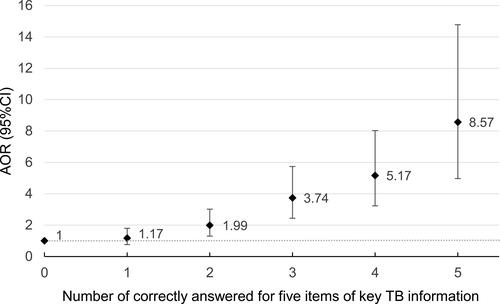Figures & data
Table 1 Sociodemographic Characteristics and Differences in Health-Seeking Preference of Participants in Zhejiang, China (n=7174)
Table 2 The Association Between Knowledge of TB and Health-Seeking Preference Among Participants Who Knew About TB in Zhejiang, China (n=6013)
Table 3 Predictors of Health-Seeking Preference Among Participants Who Knew About TB in Zhejiang, China (n=6013)
Figure 1 The association between knowledge of TB and health-seeking behavior among participants who knew about TB in Zhejiang, China (n=6013).
Notes: 1) When residence, education, marriage, and occupation were adjusted for, participants with higher scores based on correct answers on five items of key information were more likely to get appropriate health-seeking preference. 2) Compared to participants with a score of 0, participants with a score of 5 were 8.57 times more likely (95% CI, 4.97–14.78) to have appropriate health-seeking preference, followed by participants with a score of 4 (OR=5.99; 95% CI, 3.23–8.03), a score of 3 (OR=3.74; 95% CI, 2.44–5.74); a score of 2 (OR=1.99; 95% CI, 1.30–3.02); and a score of 1 (OR=1.17; 95% CI, 0.76–1.80). 3) Appropriate health-seeking preference of the participants increased as the key knowledge scores increased.

